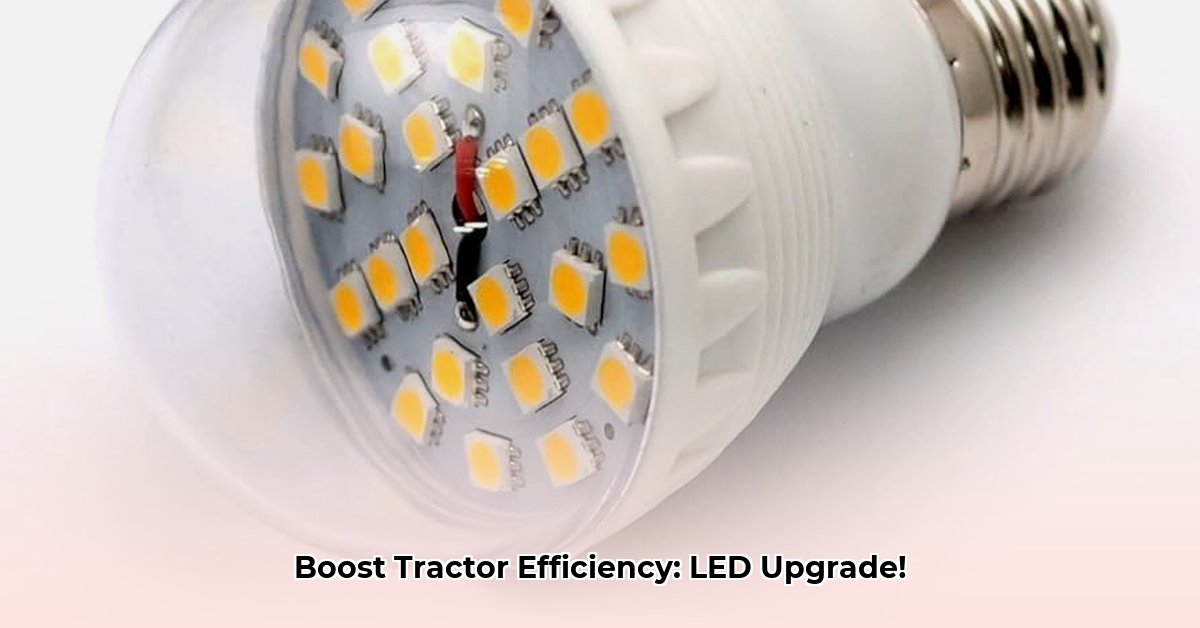
Farming demands long hours, often extending into the night. Poor lighting compromises safety, reduces productivity, and impacts your bottom line. But what if you could illuminate your nighttime operations with brighter, longer-lasting lights that also save you money? This guide shows you how to upgrade your tractor's lighting to energy-efficient LEDs, maximizing both efficiency and sustainability. We'll cover the reasons for switching, guide you through the selection process, detail installation tips, address potential challenges, and highlight the long-term benefits. Whether you are a seasoned farmer or just starting, this guide provides actionable steps toward a brighter, more efficient, and sustainable farming future. For additional ways to improve your tractor's performance, check out these tractor heating options.
Why Upgrade to LED Tractor Lights?
Traditional incandescent and halogen bulbs are energy-hungry and short-lived, leading to frequent replacements and increased operational costs. LEDs offer a significant advantage across multiple key areas: superior brightness, dramatically improved energy efficiency, exceptional durability, and ultimately, lower long-term operational costs.
Imagine this: you're working late, struggling to see clearly under the weak glow of your current tractor lights. Now, picture bright, crisp LED lights illuminating your workspace, improving precision and safety.
Increased Brightness: LEDs deliver significantly higher lumen output (a measure of light brightness) than traditional bulbs, even at lower wattage. This translates to superior visibility, enhancing safety and productivity, especially in low-light conditions.
Energy Efficiency: LEDs consume far less energy than traditional bulbs, resulting in substantial savings on your electricity bills. "Switching to LEDs can reduce your energy consumption by up to 80%," states Dr. Emily Carter, Professor of Chemical and Biological Engineering at Princeton University, highlighting the significant potential for cost savings.
Durability and Longevity: Modern LEDs boast impressive IP ratings (Ingress Protection, indicating resistance to water and dust), robust construction (often with aluminum housings for optimal heat dissipation), and significantly extended lifespans compared to traditional incandescent or halogen bulbs. This translates to reduced maintenance and fewer replacements, minimizing downtime and long-term costs.
Lower Long-Term Operational Costs: While the initial investment in LEDs may be higher, the long-term savings from reduced energy consumption and infrequent replacements significantly outweigh the upfront costs. Although comprehensive comparative data on Total Cost of Ownership (TCO) remains limited, the evidence strongly suggests considerable long-term financial benefits. A carefully considered cost analysis, however, factoring in your specific usage patterns and local energy prices, is crucial for accurate TCO calculation.
Choosing the Right LED Work Lights: A Step-by-Step Guide
Selecting the ideal LED work lights requires careful consideration of compatibility, brightness, durability, and cost.
Step 1: Compatibility: Verify compatibility with your specific tractor model (John Deere, Case IH, Massey Ferguson, etc.). Consult your tractor's manual or contact your dealer to ensure proper fitment and avoid electrical issues.
Step 2: Brightness and Wattage: Lumens (lm) measure brightness; higher lumens equate to brighter illumination. Wattage (W) indicates energy consumption; LEDs deliver high lumens with lower wattage, representing significant energy savings. Select lumen output based on task requirements: higher lumens for fieldwork, lower for close-range tasks.
Step 3: Durability and Features: Prioritize high IP ratings (e.g., IP67 for superior water and dust resistance) and robust construction materials (aluminum housings are preferred for heat dissipation). Consider features like vibration resistance for rough terrain operation, and various mounting options for flexible placement.
Step 4: Cost Considerations: While the initial investment in LEDs is typically higher, their extended lifespan and reduced energy consumption lead to substantial long-term savings. Calculate the TCO, considering initial purchase price, installation costs, energy savings over the bulb's lifespan, reduced replacement frequency, and any available rebates or financing options. This detailed analysis will ensure a profitable investment strategy.
Installation and Maintenance: Ensuring Optimal Performance
LED tractor light installation is usually straightforward, following the manufacturer’s instructions. However, if you're uncomfortable with electrical work, consult a qualified electrician. Regular maintenance, such as cleaning to remove dust and debris, is crucial for optimal performance and longevity.
Addressing Potential Challenges: Practical Solutions
The transition to LED tractor lights may present some challenges:
Lack of Standardization: Inconsistent standards across manufacturers can lead to compatibility issues. Always verify compatibility with your tractor model before purchasing.
Limited Comparative TCO Data: The lack of readily available comparative TCO data makes direct financial comparisons challenging. Conducting preliminary pilot tests with a few LED bulbs can provide valuable real-world data for informed decision-making.
Compatibility Concerns: Some older tractor models may present compatibility challenges. Consulting with your equipment dealer or an experienced electrician is advisable to ensure proper installation and functionality.
Conclusion: Illuminating a Sustainable Agricultural Future
Upgrading your tractor's lighting to LEDs is a strategic investment in the long-term efficiency and sustainability of your farm. Although challenges exist, the benefits – improved safety, reduced operational costs, and environmental responsibility – make this transition a compelling choice for modern agriculture. By carefully considering compatibility, brightness, durability, and TCO, farmers can significantly enhance their operations while contributing to a greener future.